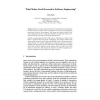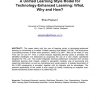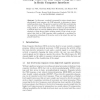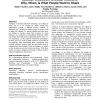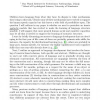7839 search results - page 29 / 1568 » What's there and what's not |
STTT
2002
13 years 8 months ago
2002
Physics, biology, and medicine have well-refined public explanations of their research processes. Even in simplified form, these provide guidance about what counts as "good re...
IJDET
2010
13 years 6 months ago
2010
: This paper deals with the use of learning styles in technology-enhanced learning, by introducing a so-called "Unified Learning Style Model" (ULSM). The article aims at ...
BRAIN
2010
Springer
13 years 5 months ago
2010
Springer
Abstract. In this paper, a method is proposed for using a simple neurophysiological brain response, the N400 potential, to determine a deeper underlying brain state. The goal is to...
CHI
2005
ACM
14 years 9 months ago
2005
ACM
Advances in location-enhanced technology are making it easier for us to be located by others. These new technologies present a difficult privacy tradeoff, as disclosing one's...
EELC
2006
14 years 9 days ago
2006
nstructional schemas, both specific and abstract. Children are thought to start out with concrete pieces of language and to gradually develop more schematic constructions. All cons...
